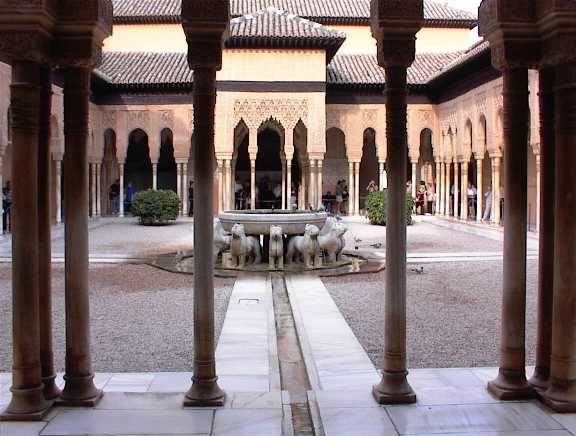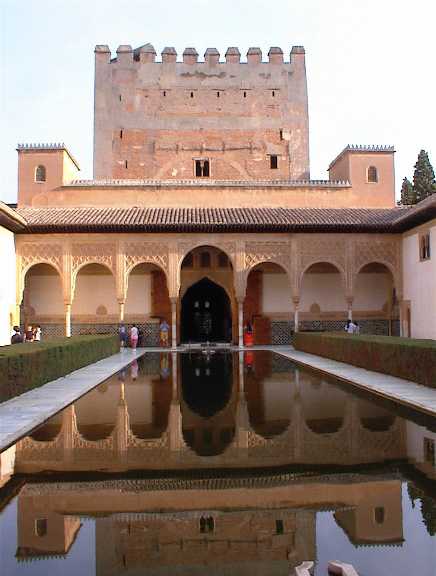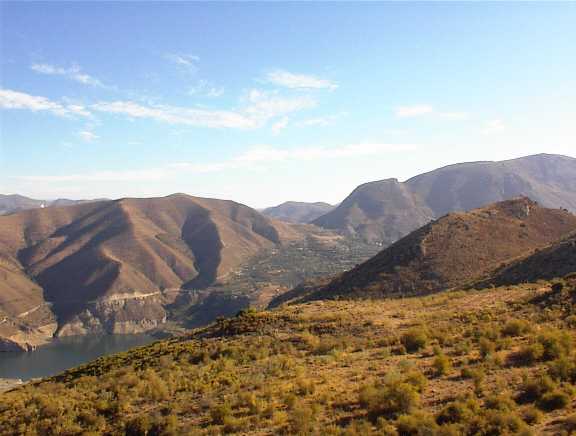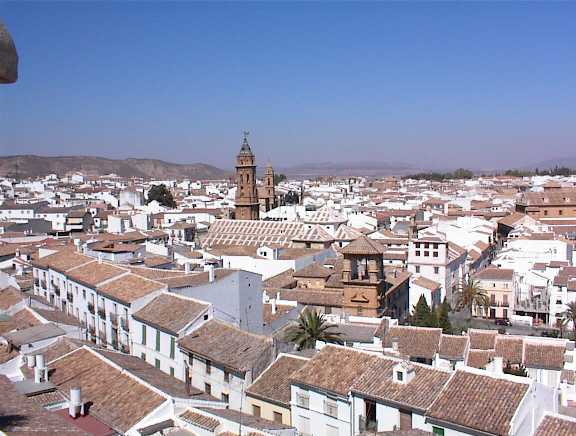Sunday 12 September 1999
It is quite a drive out to Úbeda.
The first part on the motorway is not so bad, but the final 40km are a lot
slower. Úbeda too, lies on higher ground. Úbeda had it heydays in the 16th
century when it was ruled by two families: Cobos and Molinos. They hired Andrés
de Vandelvira as an architect. Most historical buildings in the town were
designed by him. Shortly  thereafter
Úbeda lost its prominent position. About as quickly as she had gained it.
That's why there is so much unity in style in the old town. In the old town next
to a renaissance church is the Condestable Dávolos, partly a design by
Vandelvira. It is now the Parador of Úbeda. It is a former family palace and
was built around a delightful patio, now used as the hotel bar. We have a nice
room with a view of the square. The monumentality of the place becomes even more
obvious inside our room. The room is yet even higher than it is wide or long. We
visit the El Salvador chapel next door to the Parador. it is a renaissance
church from 1536. It used to be the private chapel of an advisor to Charles V.
In Úbeda there quite a number of interesting churches, like the Oratorio de San
Juan de la Cruz and San Pablo church. At night we have some tapas at the
restaurant Meson Navarra. Up till now the best we had, nicely finished with
toast, lettuce en garnish. Of course we have dinner in the Parador. This time we
do not take the excellent red Marques de Cáceres (house wine of the
Paradores), but the equally tasty Marques de Riscal.
thereafter
Úbeda lost its prominent position. About as quickly as she had gained it.
That's why there is so much unity in style in the old town. In the old town next
to a renaissance church is the Condestable Dávolos, partly a design by
Vandelvira. It is now the Parador of Úbeda. It is a former family palace and
was built around a delightful patio, now used as the hotel bar. We have a nice
room with a view of the square. The monumentality of the place becomes even more
obvious inside our room. The room is yet even higher than it is wide or long. We
visit the El Salvador chapel next door to the Parador. it is a renaissance
church from 1536. It used to be the private chapel of an advisor to Charles V.
In Úbeda there quite a number of interesting churches, like the Oratorio de San
Juan de la Cruz and San Pablo church. At night we have some tapas at the
restaurant Meson Navarra. Up till now the best we had, nicely finished with
toast, lettuce en garnish. Of course we have dinner in the Parador. This time we
do not take the excellent red Marques de Cáceres (house wine of the
Paradores), but the equally tasty Marques de Riscal.
Monday 13 September 1999
After the elaborate breakfast buffet we walk down to the potters' quarter. In the lower town there is a concentration of potteries around the Calle Valencia. Most prominent is Paco Tito. You walk around freely in his shop, workshop and exhibition rooms. Apart from practical and decorative pieces, Paco also makes pieces with more artistic value. Most of his work carries the typical Úbeda dark green colour. Paco has a traditional kiln, heated extra with olive stones, resulting in higher temperatures and better results - a method taken from the Moors. In all of Spain there are only six of these kilns left, three of them in this street. We back to the Parador (uphill), check out of our room and get on our way to Granada. We stay at the Hotel Reina Cristina. The have no double rooms left, but the can offer us an apartment. We have lunch on Plaza de Trinidad near the hotel. A nice and busy square, as such, with a fountain, trees and benches. The crowd is a colourful mix of young couples, tramps, students, tourists and elderly granaditos. We take a first look around town. We visit the Corral de Carbón., a former Serail from the Moorish days. This is an inn where long distance travelers used change horses. This one is unique in its kind in Spain. It now houses the local tourist board. We also have a look at the Casa de los Tiros, a Moorish building, oddly enough built just after Granada's reconquista. Although is starts getting hot, we do feel that Granada is a lot cooler than other places we've been. The afternoon does not get hotter than 27°C or 80°F. It is probably down to Granada's elevated location. In the afternoon we take a look at the Capilla Real. The chapel was built as a mausoleum to Queen Isabel and king Fernando, the royal couple that finally united all of Spain and under whose reign the last Moorish kingdom was reconquered in 1492: Granada. The couple was laid to rest here in 1522. The monument marking the grave of the monarch and their daughter Johanna the Mad and her husband Felipe, is quite impressive. The tombs themselves placed in a crypt underneath could not be any simpler. After the visit we take a taxi to the Mirador de San Nicolas. This square near the San Nicolas church is the Albaicín, the working class district of Moorish origin. From this vantage point we have an excellent view of the city and the Alhambra located on another hill. We walk a bit into the district and eat some tapas on a terrace. at the Plaza Larga. After a while the crowd becomes a bit rougher and the tourists gradually disappear. We decide to do the same. We descend down the hill through the Albaicín to the city centre. We have a drink at the Plaza Nueva at the heart of Granada's modern centre. Good for some "people watching".
Tuesday 14 September 1999
We rise early. The night was rather noisy. Our
neighbours in the apartment upstairs, make a lot of noise and the rooms have
very thin walls. We ask for a room in the hotel itself, which we manage to get - after some
haggling. We head for the Alhambra, sight number  one
of Granada. There is a useful shuttle bus service to the Alhambra from the city
centre (Plaza Nueva), which saves us from a steep climb or serious traffic and
parking problems. Before nine we are at the gates. We get a ticket with coupons
for the different parts of the complex. For the Nasrid palaces we get a entry
time slot by which time we must enter. You can't get in before
or after. Our slot is from 9.30 and 10am. Once inside we can stay as long as we
want. When we get out around two pm we see that all tickets for the day have been
sold out. Thanks to this new crowd control policy the palaces are relatively
quiet. We rent an electronic guide, a sort of telephone, on which you can punch
in the number of the object you are in front of. You get an explanation about what
you see from the perspective of the American writer Washington Irving who spent
several months here in 1830. The route takes us through the various patios and
rooms built by the Moorish rules of Granada through the centuries. Granada was
the last Moorish kingdom to fall in the hands of the Christian kings of Spain in
1492. Thankfully they liked it and the alterations have kept to a minimum.
Charles V built his own palace next to the Nasrid palaces out of practical
reasons: the Nasrid palace was too cold in winter. Walking through the palaces
you get from one surprise to the other. It is so beautiful. Best is the Patio of
the Lions. In the middle of it is a fountain carried by images of lions. It is
impressive to see what water works the Moors were capable of with the limited
technology available at the time.
one
of Granada. There is a useful shuttle bus service to the Alhambra from the city
centre (Plaza Nueva), which saves us from a steep climb or serious traffic and
parking problems. Before nine we are at the gates. We get a ticket with coupons
for the different parts of the complex. For the Nasrid palaces we get a entry
time slot by which time we must enter. You can't get in before
or after. Our slot is from 9.30 and 10am. Once inside we can stay as long as we
want. When we get out around two pm we see that all tickets for the day have been
sold out. Thanks to this new crowd control policy the palaces are relatively
quiet. We rent an electronic guide, a sort of telephone, on which you can punch
in the number of the object you are in front of. You get an explanation about what
you see from the perspective of the American writer Washington Irving who spent
several months here in 1830. The route takes us through the various patios and
rooms built by the Moorish rules of Granada through the centuries. Granada was
the last Moorish kingdom to fall in the hands of the Christian kings of Spain in
1492. Thankfully they liked it and the alterations have kept to a minimum.
Charles V built his own palace next to the Nasrid palaces out of practical
reasons: the Nasrid palace was too cold in winter. Walking through the palaces
you get from one surprise to the other. It is so beautiful. Best is the Patio of
the Lions. In the middle of it is a fountain carried by images of lions. It is
impressive to see what water works the Moors were capable of with the limited
technology available at the time. After the palaces we turn to the gardens, the Generalife. We get in on the same
ticket. They are beautifully designed and also have a wonderful view of the
city. In the Alhambra is also a Parador. It is very expensive and booked almost
a year in advance. We can however have a drink and a snack there. Around two
clock we have also visited the Alcazaba (the fortress next to the Alhambra) and
we take the shuttle bus downtown. We have lunch at the Plaza Nueva.
After the palaces we turn to the gardens, the Generalife. We get in on the same
ticket. They are beautifully designed and also have a wonderful view of the
city. In the Alhambra is also a Parador. It is very expensive and booked almost
a year in advance. We can however have a drink and a snack there. Around two
clock we have also visited the Alcazaba (the fortress next to the Alhambra) and
we take the shuttle bus downtown. We have lunch at the Plaza Nueva.
Before dinner we take some tapas and drinks at the Bodega Castañeda. It is a must! It is a classical type of bar, where you can take your snacks and drink standing up. The tables are for simple meals only. Their menu of tapas is impressive and the place has been tastefully decorated. They also serve some interesting cocktails, among which the Caliscasas, a mix of about everything for sale behind the bar. It tastes great! We finish the evening in the Tic-Tac bar, a nice no-nonsense gay bar.
Wednesday 15 September 1999
Today we drive into the Sierra Nevada
mountains. Slowly but surely we are ascending. The air becomes thinner and
temperatures drop to 13°C
or 55°F. The village of Solynievas is an ugly ski resort. This time of year it
is practically deserted, but for the construction workers, building yet more
hotels. But we can go even higher for even nicer views. It is even possible to
walk the last bit to the summit of the  Veleta.
We stop at ±2.550 (7400 ft). Here we find
a statue of the virgin Mary, heavily visited by a bus load of old age
pensioners, who are adamant to leave their name somewhere (some even use their
lipstick) on the monument.
Veleta.
We stop at ±2.550 (7400 ft). Here we find
a statue of the virgin Mary, heavily visited by a bus load of old age
pensioners, who are adamant to leave their name somewhere (some even use their
lipstick) on the monument.
We drive back to Granada, and immediately on to the Alpujarras. We get out of the car in Lanjaron. It is a Spa, where most of Spain's bottles mineral water comes from. It is also very dull. We have lunch there and move on to Ogivia. A smaller town, but also deeply sunk into its siesta. We drive back to Granada again by winding, makes us half giddy by the time were back. At night we have some tapas at the Café Centro (next door to Castañedas).
We want to explore the Granada gay scene in more detail tonight, but after a couple of attempts (many bars are virtually empty , but for the staff), we end up good old Tic-tac, where there is a nice crowd.
Thursday 16 September 1999
After breakfast we leave
Granada for Antequerra. We find a very simple guesthouse
(Hostal Manzanito) owned by somewhat sullen old woman. We look around
Antequerra. The Carmelite nunnery of San José has cakes and sweets on
sale. The merchandise is on display in a window from which we can make our
choice. We then have to ring the bell. We here a nun through a hole in the wall
asking for our order. We get our cakes through some kind of revolving door, but we never get to see the nun serving us.
The nun never get out anyway! We walk up the hill overlooking the town to the Nuestra
Señora del Carmen. The church has dull façade, but inside the late baroque
wood carved altarpiece is impressive.
through some kind of revolving door, but we never get to see the nun serving us.
The nun never get out anyway! We walk up the hill overlooking the town to the Nuestra
Señora del Carmen. The church has dull façade, but inside the late baroque
wood carved altarpiece is impressive.
In the afternoon we drive to the Laguna de Fuente de Piedra, a salty lake and habitat for the Great Flamingos. Because of years of draught and heavy asparagus farming in the area the water level has dropped dramatically in summer When we got there only a tiny corner of the lakes basin was wet and had a group of birds in it. From our view point we could only see them with our binoculars. In spring it will be a much better sight, no doubt, but in September it is not worth the trouble. We get back to Antequerra and head immediately for El Torcal. This a mountain plateau shaped by glaciers thousands of years ago. There is a visitor centre with explanatory displays on the wildlife around.
At night we have dinner in a restaurant (El Escribando) inside the walls of the Moorish castle. A good place to eat as such, but the waiter staff make a mess of the evening.
Friday 17 September 1999
After one night in the guest house we long again for one last night of luxury. We decide to spend our last night in Spain in a Parador. But most Paradors around turn out to be fully booked. We can only get a room in Antequerra itself. And that's what we decide to do. Antequerra's Parador is a modern building, a normal luxury hotel. The furnishings are in bad need of replacement. After haven taken up are room we are on our way to El Chorro. The road there takes us through valleys and past mountains and various hairpin curves. El Chorro is a strange place. It is enourmous canyon, cut out by the river Guadalhorce. The attraction is the Camino del Rey, sort of concrete catwalk glued to the mountain wall. Built as part of the water power plants. These days is has been badly neglected. There are holes in it and some part lack any kind of railing. Still there are some dare devils who defy the dangers We drive on and turn of the main road in the direction of a view point where we should find two restaurants, according to the road signs at least. The narrow roads winds around the mountain going up steeply. After a good fifteen minutes we find out that one of the restaurants has been deserted and is for sale. We continue on our way up. Once at the top we get to a small cafeteria, where can eat a simple sandwich. The view is magnificent, the area quite deserted. We look down on a number of lakes, some used for generating electric power. After having admired the scenery for a while we drive back to Antequerra.
We take in our poolside positions at the Parador. The water is lovely for swimming, but flies harassing us when we want to enjoy the sun are a pest.. At night we have dinner in the Parador.
Saturday 18 September 1999
Our last day of our holiday starts with a luxurious breakfast. We drive down to Malaga. We visit the busy covered market and stroll around the city. Not bad, but without real impressive sights. The cathedral is open to visitors but not very special. Around 1.30 public life in Granada grinds to a halt and we retire to a bench in the park. In the late afternoon we do some shopping. We leave for the airport around seven. We hand the car and check in for our flight back to Rotterdam. We are there in good time. The flight back ends a great holiday. We land in Rotterdam around 12.30am and take taxi back home.